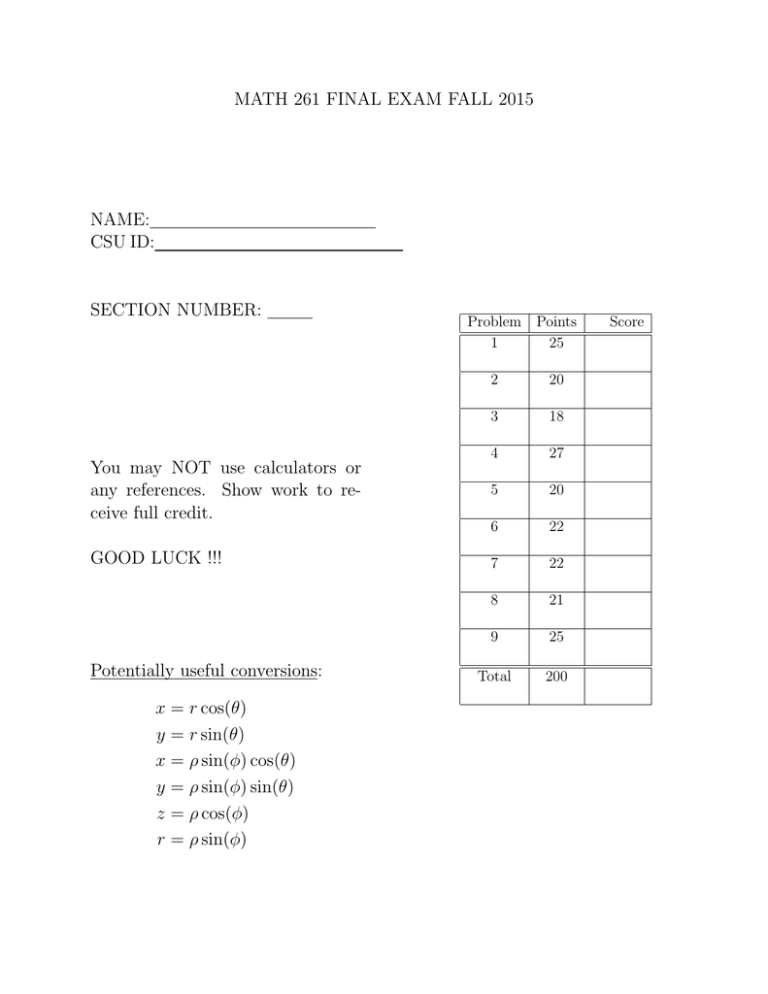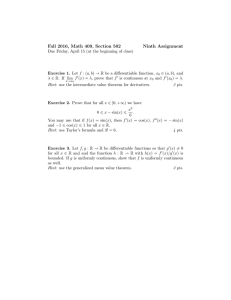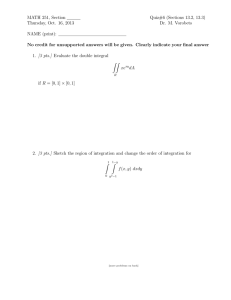MATH 261 FINAL EXAM FALL 2015 NAME: CSU ID: SECTION NUMBER:
advertisement

MATH 261 FINAL EXAM FALL 2015 NAME: CSU ID: SECTION NUMBER: Problem Points 1 25 2 20 3 18 4 27 You may NOT use calculators or any references. Show work to receive full credit. 5 20 6 22 GOOD LUCK !!! 7 22 8 21 9 25 Total 200 Potentially useful conversions: x = r cos(θ) y = r sin(θ) x = ρ sin(φ) cos(θ) y = ρ sin(φ) sin(θ) z = ρ cos(φ) r = ρ sin(φ) Score The instructors will not answer questions about this page during the exam. f is a real valued function and F(x, y, z) = M i + N j + P k is vector valued. (If in R2 then P = 0.) T is an appropriate unit tangent vector and n is an appropriate unit normal vector. ∂r r(t) is a parameterization of a curve; r(u, v) is a param. of a surface, with ru = ∂u and rv = ∂∂vr Divergence: Curl: ∂N ∂P ∇ · F = div F = ∂M ∂x + ∂y + ∂z ∂P ∂N ∂M ∂P ∂N ∂M ∇ × F = curl F = − i+ − j+ − k ∂y ∂z ∂z ∂x ∂x ∂y ∂N ∂M ∇×F·k= − (2 dimensional) ∂x ∂y Z Z b f (x, y, z) ds = f (g(t), h(t), k(t))|v(t)| dt Line Integral along a curve C : C a Line Integrals on closed curves may also be evaluated using Green’s Theorem, below. Work, Flow along a curve C : Z Z F · T ds = C M dx + N dy C Flux of vector field F:Z across curve C ⊂ R2 : Z F · n ds = M dy − N dx C ZZ C ZZ 3 through surface S ⊂ R : F · n dσ = F · (ru × rv ) dudv. S S Z ∇f · dr = f (finish) − f (start). Fundamental Theorem for Line Integrals: C Green’s Theorem F = M i + N j in R2 . Region R has boundary C. I ZZ ZZ ∂N ∂M Work/Circ/Flow = F · T ds = − dx dy = ∇ × F · k dx dy, ∂x ∂y R R C ZZ I ZZ ∂M ∂N F · n ds = ∇ · F dx dy Flux = + dx dy = ∂x ∂y R R C Surface Integral of g over the surface S (g(x, y, z) = 1 for surface area): ZZ ZZ g(x, y, z) dσ = g(r(u, v))|ru × rv | du dv, with parameters u, v in R. . S R Stokes’s Theorem: Surface S with boundary curve C. I ZZ ZZ Work/Circ/Flow = F · dr = ∇ × F · n dσ = ∇ × F · (ru × rv ) du dv. C S S Divergence Theorem : Solid D with boundary surface S. ZZ ZZZ Flux = F · n dσ = ∇ · F dV S D 1. (25 pts; 5 per part) For (a), (b), and (c), do the computation indicated and simplify your answer. (a) |h3, 4i| (b) h1, 0, 2i · h3, 1, 2i (c) h1, 0, 2i × h3, 1, 2i (d) Find the parametrization r(t) of the line segment from (0, 1) to (3, 1) so that r(0) = (0, 1) and r(1) = (3, 1). (e) Give an equation in the form Ax + By + Cz = D for the plane including the point (1, 0, 2) and with normal vector h2, 1, 3i. 2. (20 pts; 10 per part) The two parts of this problem are independent. (a) Find an equation for the plane tangent to the surface given by x2 + 2y 3 + z 2 = 8 at the point (2, 0, 2). Please give your answer in the form Ax + By + Cz = D. (b) Find a vector parallel to the line of intersection of the planes given by x+y +z = 2 and 3x + y + 4z = 6. 3. (18 pts; as indicated) (a) (12 pts) Write the system of equations to be solved when using Lagrange multipliers to find the point P on the circle (x − 1)2 + (y + 1)2 = 2 farthest from the origin. (b) (6 pts) Find point P using any method you want. 4. (27 pts; 9 per part) The three parts of this problem are independent. (a) Write, but DO NOT SOLVE, the system of equations to be solved in order to find the critical points of the function f (x, y, z) = x cos(y) + y sin(x) + z 2 . ( 3x2 + 6y = 0 (b) Solve the system of equations to find the two critical points of 2y + 6x = 0 g(x, y) = x3 − y 2 + 6xy − 18, but DO NOT CLASSIFY THEM. 2 2 as a local minimum, a local max(c) Classify each of the points (0, 0) and − , 3 3 imum, or a saddle point of the function h(x, y) = x2 + y 3 + 2xy − 15. 5. (20 pts) Let T be the solid object depicted below. The left figure is a view from above, but not directly above. The right figure is a view from directly above, so you can see that the projection onto the (x, y)-plane is an annulus (pair of concentric circles) with center atp the origin, inner radius 1, and outer radius 3. The upper surface of T is given by z = 1 − (2 − r)2 (in cylindrical coordinates). The lower surface is just z = 0. Write down one triple integral in cylindrical coordinates to compute the volume of T BUT DO NOT EVALUATE IT. 6. (22 pts) Consider the helical curve C parameterized by r(t) = hcos(t), sin(t), ti with 0 ≤ t ≤ 4π Find the work done by vector field hx, y, zi along C. 7. (22 pts) Consider the portion of the paraboloid z = 4 − x2 − y 2 above the (x, y)plane. One parameterization for this surface is r(r, θ) = hr cos(θ), r sin(θ), 4 − r2 i, with 0 ≤ r ≤ 2 and 0 ≤ θ ≤ 2π. Write down BUT DO NOT EVALUATE a double integral in r and θ that computes the integral of g(x, y, z) = z 2 over this surface. H 8. (21 pts) Use either version of Green’s Theorem to EVALUATE C y 3 dx − x3 dy as a double integral, where C is the circle of radius 3 centered at the origin and with counterclockwise orientation. 9. (25 pts) Let S be the surface of the cylinder given by x2 + y 2 = 4 with 0 ≤ z ≤ 3, including the top and the bottom. Set up a triple integral in cylindrical coordinates to compute the flux of F = hxy, yz, xzi across surface S BUT DO NOT EVALUATE IT.






